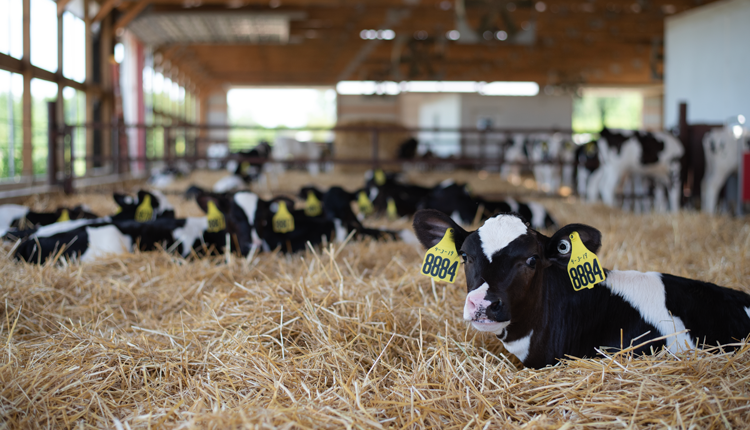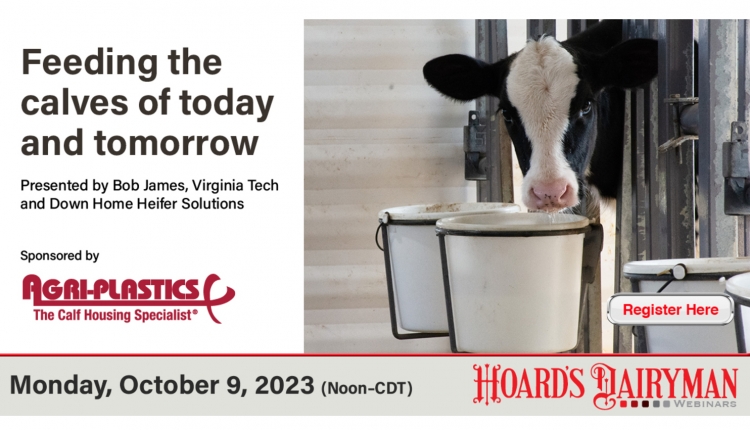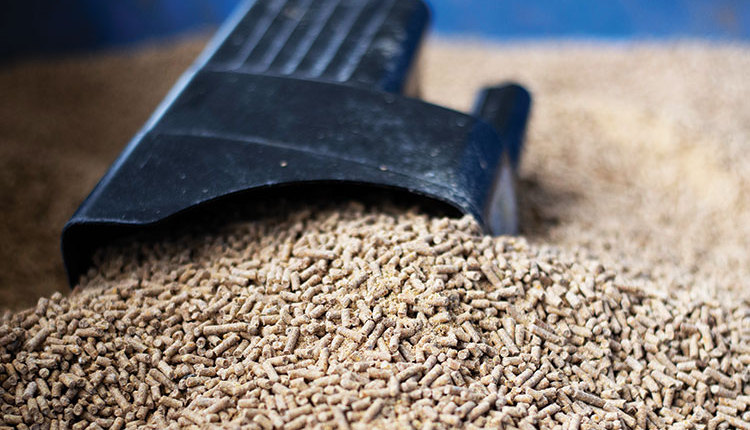The author is the principal in Adhil, LLC, a St. Louis-based consulting firm.
Much calf research has been done under what is called a thermal neutral ambient temperature of 68°F. It is the temperature range in which the calf does not need to expend appreciable energy to either keep warm or to keep cool. Typically, it ranges from about 60 to 75°. This temperature range is particularly critical for calves under 2 to 3 weeks of age for they have limited calf starter intake which means they have little heat from rumen fermentation to help keep them warm in colder weather.
So what are the options in colder weather? Well, you can feed more of a milk replacer or pasteurized waste milk, use a higher-fat-level replacer, or add a fat supplement to the liquid feeding program. Simply feeding more may seem like the most straightforward approach, but that means you will overfeed protein.
Using a higher fat replacer is an option, but that means having a second replacer to feed and maybe overfeeding energy, depending on the weather, age, and starter intake of the calves. The option of using a fat supplement may provide the greatest flexibility but still requires you to make some decisions and watch what you're doing.
I want to explore this option in this article because it also lends itself to illustrate the greater energy needs due to colder weather. The particular fat supplement used in these examples has 7 percent protein and 60 percent fat in dry form. (In the interest of disclosure, I consult for a company that has such a product.)
I will use the Young Calf Model in the 2001 National Research Council's Nutrient Requirements of Dairy Cattle. Calf weights of 80, 100, 120, and 140 pounds were used with ambient temperatures of 60, 50, 40, 30, 20, 10, and 0°F. I used a 20 percent protein/20 percent fat replacer at 10 ounces per 2 quarts fed twice daily. That equates to 1.25 pounds dry replacer daily. The fat supplement was fed at 2 ounces per replacer feeding which resulted in 0.25 pound fed daily. This boosts the solids level in the replacer from 12.5 to 15 percent, still a reasonable solids feeding level.
With the 80-pound calf (Figure 1), the replacer alone provided enough energy for just over a pound daily gain at 60°. But now notice (yellow bars) that, as the temperature drops by 10° intervals, gain drops off to the point that, at 10°, the replacer alone provides for no daily gain. At 0°, the replacer alone results in a weight loss.
The gains predicted are energy-based daily gain. Protein gain really does not change with the cold.
Feeding 0.25 pound or 4 ounces of the fat supplement (see red bars) beginning at 50° provided enough additional energy for 0.5 to 0.6 pound more daily gain down to 0°F. The blue bars show the net effect of combining both replacer and fat supplement for energy-allowable daily gain.

More calf, more needs . . .
Figure 2 shows that an additional 20 pounds of calf weight versus Figure 1 lowered daily gain by about 0.4 pound across the temperature range of 50 down to 0°. The fat supplement still provided 0.5 to 0.6 pound daily gain, but the contribution of the replacer was so much lower simply due to the greater maintenance needs that go with another 20 pounds of calf.
And the combined energy contribution from both replacer and fat supplement barely maintained any daily gain at 0°F. This marked effect of 20-pound increments in calf size is seen more dramatically in Figure 3 which is set at 30°. For the 120-pound calf, replacer alone resulted in negative daily gain, while the 140-pound calf netted out zero daily gain (no blue bar visible) even with 0.25 pound of the fat supplement.
With both 120- and 140- pound calves, there should be significant starter intake. The impact of that can be considerable. For instance, a quarter pound starter intake for the 120-pound calf would boost expected gain by about 0.3 pound while an intake of one-half pound starter would jump gain to 0.5 pound at 20°. Naturally, this gain would be somewhat less, maybe 0.1 pound, with a 140-pound calf due to its greater size and maintenance.
But, remember, calves need about four times as much water intake as starter intake. This means needing to feed warm water in winter and doing it up to three times daily.
How critical is warm water? A recent Oklahoma State study showed that steers had reduced rumen content temperature by an average of 4° and up to 7° when they drank normal temperature water. This change negatively impacts rumen fermentation until the temperature is returned to normal. Not feeding warm water would also cause the calf to use additional energy to warm up the just consumed, colder water.
So how does this all net out? First, develop the best approach for your operation to adjust the liquid feeding program for your calves in winter weather. From this graph, you can see you need to make allowance for an additional 0.5 pound daily gain during colder winter months. For the younger calves, that needs to come from the liquid feeding program. For bigger calves, that may require some additional energy through the liquid feeding program, but it does require greater attention to getting good starter intake. This, in turn, requires that you make sure you feed warm water.
Much calf research has been done under what is called a thermal neutral ambient temperature of 68°F. It is the temperature range in which the calf does not need to expend appreciable energy to either keep warm or to keep cool. Typically, it ranges from about 60 to 75°. This temperature range is particularly critical for calves under 2 to 3 weeks of age for they have limited calf starter intake which means they have little heat from rumen fermentation to help keep them warm in colder weather.
So what are the options in colder weather? Well, you can feed more of a milk replacer or pasteurized waste milk, use a higher-fat-level replacer, or add a fat supplement to the liquid feeding program. Simply feeding more may seem like the most straightforward approach, but that means you will overfeed protein.
Using a higher fat replacer is an option, but that means having a second replacer to feed and maybe overfeeding energy, depending on the weather, age, and starter intake of the calves. The option of using a fat supplement may provide the greatest flexibility but still requires you to make some decisions and watch what you're doing.
I want to explore this option in this article because it also lends itself to illustrate the greater energy needs due to colder weather. The particular fat supplement used in these examples has 7 percent protein and 60 percent fat in dry form. (In the interest of disclosure, I consult for a company that has such a product.)
I will use the Young Calf Model in the 2001 National Research Council's Nutrient Requirements of Dairy Cattle. Calf weights of 80, 100, 120, and 140 pounds were used with ambient temperatures of 60, 50, 40, 30, 20, 10, and 0°F. I used a 20 percent protein/20 percent fat replacer at 10 ounces per 2 quarts fed twice daily. That equates to 1.25 pounds dry replacer daily. The fat supplement was fed at 2 ounces per replacer feeding which resulted in 0.25 pound fed daily. This boosts the solids level in the replacer from 12.5 to 15 percent, still a reasonable solids feeding level.
With the 80-pound calf (Figure 1), the replacer alone provided enough energy for just over a pound daily gain at 60°. But now notice (yellow bars) that, as the temperature drops by 10° intervals, gain drops off to the point that, at 10°, the replacer alone provides for no daily gain. At 0°, the replacer alone results in a weight loss.
The gains predicted are energy-based daily gain. Protein gain really does not change with the cold.
Feeding 0.25 pound or 4 ounces of the fat supplement (see red bars) beginning at 50° provided enough additional energy for 0.5 to 0.6 pound more daily gain down to 0°F. The blue bars show the net effect of combining both replacer and fat supplement for energy-allowable daily gain.

More calf, more needs . . .
Figure 2 shows that an additional 20 pounds of calf weight versus Figure 1 lowered daily gain by about 0.4 pound across the temperature range of 50 down to 0°. The fat supplement still provided 0.5 to 0.6 pound daily gain, but the contribution of the replacer was so much lower simply due to the greater maintenance needs that go with another 20 pounds of calf.
And the combined energy contribution from both replacer and fat supplement barely maintained any daily gain at 0°F. This marked effect of 20-pound increments in calf size is seen more dramatically in Figure 3 which is set at 30°. For the 120-pound calf, replacer alone resulted in negative daily gain, while the 140-pound calf netted out zero daily gain (no blue bar visible) even with 0.25 pound of the fat supplement.
With both 120- and 140- pound calves, there should be significant starter intake. The impact of that can be considerable. For instance, a quarter pound starter intake for the 120-pound calf would boost expected gain by about 0.3 pound while an intake of one-half pound starter would jump gain to 0.5 pound at 20°. Naturally, this gain would be somewhat less, maybe 0.1 pound, with a 140-pound calf due to its greater size and maintenance.
But, remember, calves need about four times as much water intake as starter intake. This means needing to feed warm water in winter and doing it up to three times daily.
How critical is warm water? A recent Oklahoma State study showed that steers had reduced rumen content temperature by an average of 4° and up to 7° when they drank normal temperature water. This change negatively impacts rumen fermentation until the temperature is returned to normal. Not feeding warm water would also cause the calf to use additional energy to warm up the just consumed, colder water.
So how does this all net out? First, develop the best approach for your operation to adjust the liquid feeding program for your calves in winter weather. From this graph, you can see you need to make allowance for an additional 0.5 pound daily gain during colder winter months. For the younger calves, that needs to come from the liquid feeding program. For bigger calves, that may require some additional energy through the liquid feeding program, but it does require greater attention to getting good starter intake. This, in turn, requires that you make sure you feed warm water.









